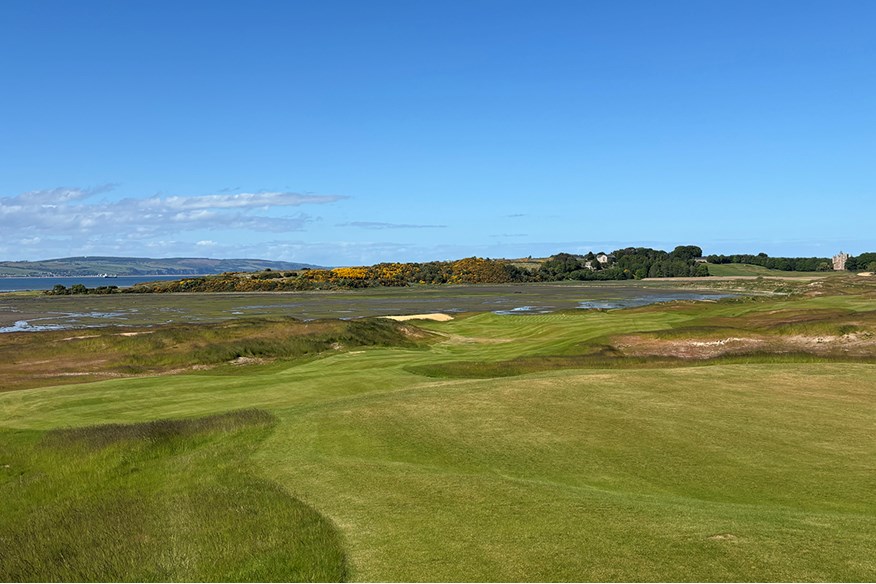I’ve had the first look at Tom Doak’s new Scottish course – this is what I think
Last updated:
Our Top 100 Courses editor Chris Bertram got a privileged preview of Old Petty three months before it opens and he believes the genius of Tom Doak is going to give Cabot Highlands a second outstanding course.
Earlier this year I wrote that the past 30 years have been the second Golden Age of golf course architecture, by way of introducing the designers I think are the leading candidates to form the next generation of superstar architects.
As I drove away from Cabot Highlands after being one of the first people to walk round its new Old Petty course, two things came to mind.
First, that I was correct about the second Golden Age thing.
And second, that the next generation have it all on to maintain the standards set over the past three decades.
Why was I so impressed with the work at Old Petty? Because I believe in different hands it could have been a good course but one that lived deep, deep in the shadow of the original there, Castle Stuart.

The land for Old Petty is nothing like as visually appealing as Gil Hanse and Mark Parsinen enjoyed for Castle Stuart and instead the success of the second course was much more reliant on the skill of the architect.
Cabot Highlands owner Ben Cowan-Dewar is much smarter than me and has a much higher golf IQ, so he will have realised that, too.
He thus duly hired the best in the business – a figure with a portfolio that bears comparison with those of the great names of the Golden Age – to give his resort on the outskirts of Inverness a course that is not a distant ‘second’ to this first.
And with Old Petty three months from a soft opening, I feel sure Cowan-Dewar will be very happy he chose Tom Doak for Old Petty.
I only had one tour of the course and not a single shot was struck, but it felt as if every ounce of greatness had been extracted from the site.
The principal reason for that is a routing that is verging on genius.
I know many, many golfers will read or hear the word ‘routing’ and their eyes will glaze over. Or won’t realise or frankly care when they’ve played a course with a great routing; they just know they have enjoyed the course.
But it is important. It is the bones of the course, how it all ties together and how the golfer experiences the land and the views. It is especially important when you’re walking, as you will be at Old Petty.
This is a sweeping statement, but I think the routing separates the good from the great – both in terms of courses and architects.

Cabot Highlands’ former GM Stuart McColm – who is now VP for all Cabot’s worldwide development and also opened Kingsbarns and Castle Stuart – gave me the tour of Old Petty.
As we started out, he handed me beautiful plans (hardback and paper) of Old Petty and I must have looked at the hardback one 20 times while writing this article.
It’s here, and I hope you can see how much Old Petty’s holes dart about the site. My brain simply cannot imagine fitting that all together. No doubt after 40 years of doing it, Doak has his methods – shortcuts to success – but thinking about fitting that jigsaw together blows my tiny mind.
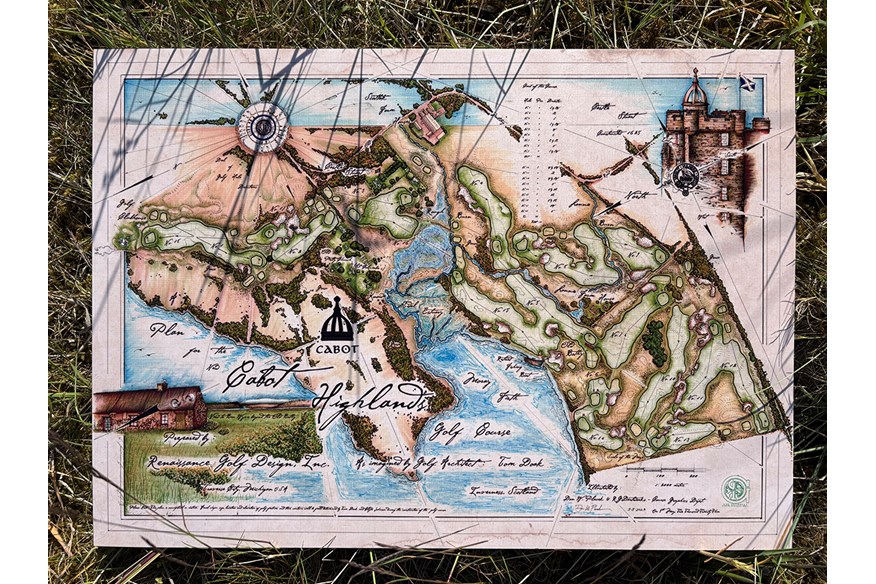
As you can hopefully see from the plan, Old Petty is far from an ‘out and back’ links; the shape of the site, a country lane, an ancient castle and the Moray Firth all dictated that.
It starts out through Castle Stuart’s original driving range and maintenance facility with two holes then at the end two holes bring us back to the clubhouse. And already Doak’s genius is evident.
The obvious direction for the 1st would have meant room only for a par 3 for the 2nd. With an obvious par 3 for the 3rd (as I will soon describe), it would have meant back-to-back short holes.
Instead, Doak’s routing has the 1st and 18th crossing each other. It gives a terrific green site between a big knoll on the left and a ridge on the right for the 1st, provides extra room for the 2nd to be a par 4 and means the 18th finishes at the base of the clubhouse.
Will it work in practice? It’s worked for centuries, and a lot of thought has gone into the 1-18 crossover. Landforms of the 1st reward the golfer that drives to the right, away from the 18th (which is to the left of the 1st tee), while golfers off the 18th should drive well past the landing zone for the 1st.
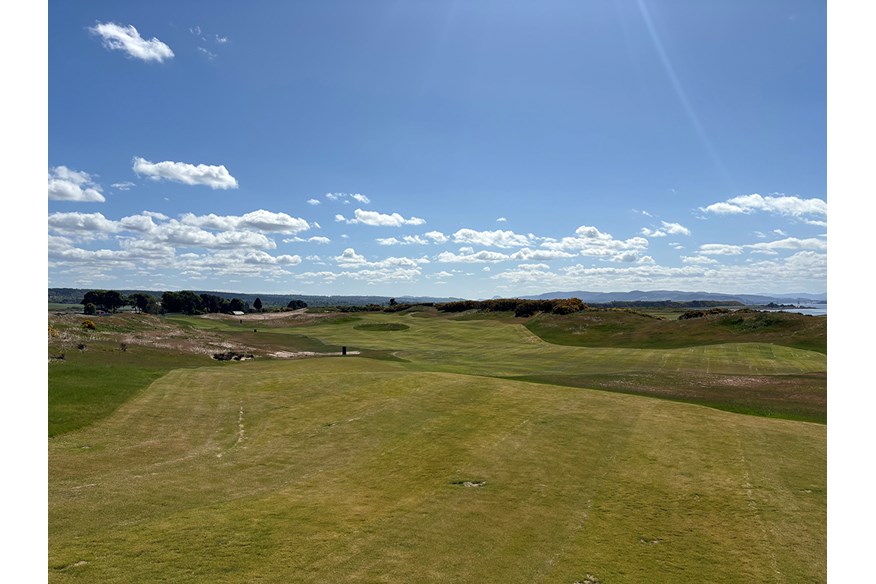
A starter will control things, but they will be required only for a third of the day. For the first three+ hours of play, no-one will be coming up 18 and for the last four no-one will be going down the 1st. Standing on the likely daily tee of the 1st, it felt like it would be no problem at all.
After you’ve negotiated the fun of the 2nd green, with a scoop out of the right-centre section, you cross the country lane and take first sight of Castle Stuart, built in 1625. A downhill par 3 sits alongside this ancient building and this striking but exacting short hole links the higher and lower ground.
The green of the 16th, which brings you back up that hillside coming, sits just to the right of the 3rd tee.
From the 4th to the 15th you play over expansive, gently rolling links terrain. That sentence, though, plays down the extraordinary journey on Old Petty’s main parcel of land.
The 4th leaps over Rough Burn and the handsome 5th across Lonnie Burn as they head in the direction of the coast towards an old bothy. The short 6th angles towards the shoreline.
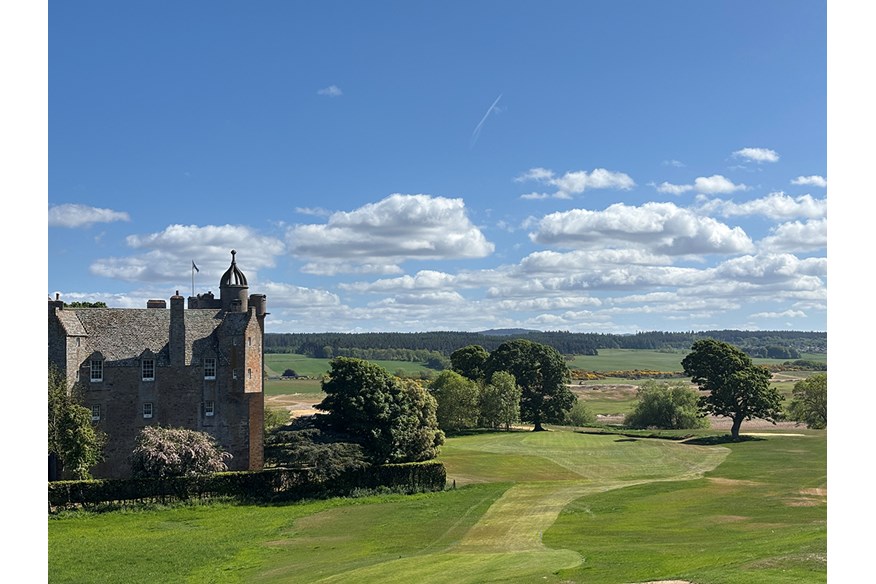
The 7th heads away from the coast on one side of a copse of mature trees, a hole that looks as if it has been there since 1625, before you turn 90 degrees and head back towards the castle for the stellar par-5 8th. There are probably two or three more attractive holes on the course – but not many that are better. Lonnie Burn is crossed again and it also plays over a bunkered ridge that gives a blind element and the prospect of the castle as your target line.
Turning 360 degrees, you cross the same burn once more for the 9th, on the outside of the property, a two-shotter that ends on an elegant, simple green with a penal run-off to the right.
A long hole, the 10th, cuts through this main section of the site from east to west, playing on the other side of the copse of trees towards the Moray Firth and offering a wonderful view as you walk up to a green that seems to creep out from underneath the base of a knoll on the left.
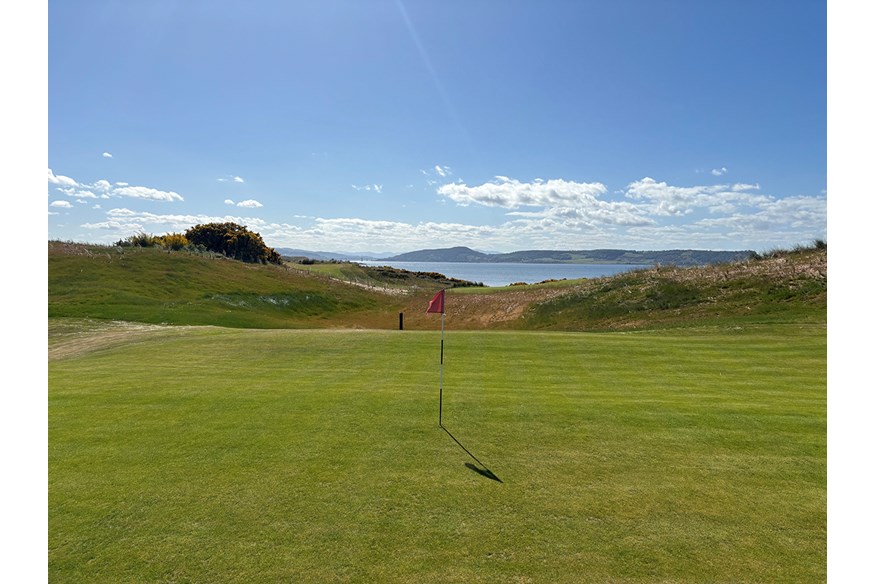
It teases the expectation of seaside holes, but in fact you turn round again and play a dog-leg back to the edge of the property. Then you swing right and clamber to the top of a hillside for the 12th, which is played parallel to the railway line on your left and ending in a cool dell for what is one of Old Petty’s most attractive greens.
The sporty par-4 13th will be a highlight, tumbling down the other side of the hill and finishing on the banks of the firth. This rise, offering an exhilarating view of the property and out over the firth, has echoes of the similar journey on Royal Dornoch’s front nine.
The next plays alongside the water, a brawny par 3 but played downhill and with a large knoll short right that should be forgiving to shots hit with the trajectory of balls hit with long clubs. Looking over the top of the flag, you will see the 3rd hole on Castle Stuart on the other side of the water.
The 15th plays along the edge of the tidal estuary, the last of what I think will be considered a quite outstanding collection of par 5s.
The 16th plays over that estuary and is linked to the course’s first section by an attractive sleepered boardwalk that was Cowan-Dewar’s suggestion.
It’s then back across the road for the short 17th that has Muirfield 13th vibes, before boarding the 18th tee and, depending on the time of day, assessing what’s happening on the 1st.
I hope that tour does justice to Old Petty’s remarkable journey. It might read like a whirlwind, but the reality is that while it is endlessly intriguing and interesting, it could not feel more tranquil.
Old Petty feels to me as if it will be a pleasing mixture of elegant, compelling holes that effortlessly hold your attention set in a beautiful, calm environment where the golf is the star. This is golf to play rather than take lots and lots of pictures of.

It has plenty of aesthetic highlights, just not quite those of its Insta-perfect sister, which travels over two linear shelves; a narrow lower section along the Moray Firth and a wider one above.
Hanse’s course has nothing like the varied routing of Old Petty, which constantly changes direction – a fact illustrated by a clever dial on the routing plan that shows the direction of play of each hole.
No two holes follow the same point on the compass and so only a third of the round can possibly ever be straight into a wind.
I also enjoyed how Old Petty embraced the existing land as well as man-made features such as the drystone walls on the 12th and 13th, notably the castle on the 3rd, and the farmhouse abutting the 5th and 6th.
“Beyond creating interesting golf, our first-most thought was to make the course feel like it belonged in Scotland, and that it belonged to that particular part of the site,” says Clyde Johnson, who was Doak’s lead associate on the project.
“From a landscape point of view there’s much less separation between the holes and golfer at Old Petty. The golfer will hopefully feel as if they’re plotting something of their own way over the site – a bit more greyscale to the strategy, rather than a distinct A vs B route to the green.
“The contouring at Old Petty is less polished, with plenty of the rumple that you find along the links course of the Moray Firth, even at Royal Dornoch.
“With maturity, Old Petty will hopefully have a timeless feel,” adds Johnson, who was one of the architects I named earlier this year as most likely to be one of the next superstars of course architecture.
That ‘unmade bed’ feel is definitely evident and I think Old Petty will feel a much more old-fashioned links than its sister.
There is more undulation on Old Petty, with fairways resembling anything from that experienced at Moray to the enormous movement of Prestwick.
The shaping is on the understated side; there is nothing contrived here, when it would have been very easy to “have got busy with it”, as McColm says.
Once the topsoil was scraped back there was literally tonnes of sand and gravel.
Some sand was transported from different areas of the site where it was light in certain areas, but none was brought in from the outside. This was a real sand palette for Doak and co to work on.
The balance of bunkering is roughly 30% revetted and the rest a rustic style. The rough will be wispy, walk-in-and-find-your-ball stuff.
Old Petty’s greens are not small and often quite large. There felt like more movement in them than on Castle Stuart, where the double-tier on the 10th is notable standout among a relatively benign collection.
As a result of those greens, if I had to guess about which of the two courses will play harder, I’d say Old Petty. It’s also 7,075 yards to a par of 71 and the changes in direction would be factors too – although the copse of trees and walls provide some respite from a breeze.
Old Petty will open for limited play in August before a full opening next May – so a full 12 months growth from when I was there. The dry winter and spring has not helped the grow-in period – nothing can replicate water from the skies – but the Cabot team are still expecting it to be ready on time.
Doak already has one Scottish links, The Renaissance Club, in his portfolio. I think Old Petty is going to surpass that, and further confirm the American’s place among the giants of course architecture.
But probably the best indication of how good I think Old Petty will be is to say that more than anything, I cannot wait to go back and play the finished product.
-
 Tom Doak's brand new course design in Scotland, Old Petty
Tom Doak's brand new course design in Scotland, Old Petty
-
 Tom Doak's brand new course design in Scotland, Old Petty
Tom Doak's brand new course design in Scotland, Old Petty
-
 Tom Doak's brand new course design in Scotland, Old Petty
Tom Doak's brand new course design in Scotland, Old Petty
-
 Tom Doak's brand new course design in Scotland, Old Petty
Tom Doak's brand new course design in Scotland, Old Petty
-
 Tom Doak's brand new course design in Scotland, Old Petty
Tom Doak's brand new course design in Scotland, Old Petty
-
 Tom Doak's brand new course design in Scotland, Old Petty
Tom Doak's brand new course design in Scotland, Old Petty
-

-
 Tom Doak's brand new course design in Scotland, Old Petty
Tom Doak's brand new course design in Scotland, Old Petty
